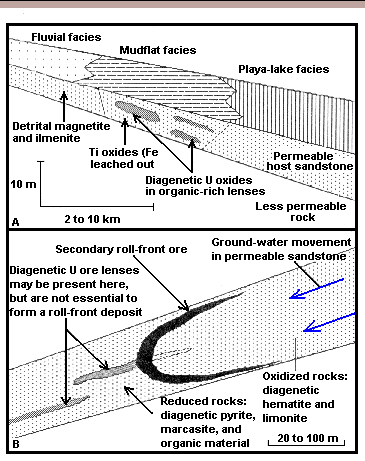
DESCRIPTIVE MODEL OF SANDSTONE U
MODEL 30c
By Christine E. Turner Peterson and Carroll A. Hodges
APPROXIMATE SYNONYMS Tabular U ore, roll front U.
DESCRIPTION Microcrystalline uranium oxides and silicates deposited during diagenesis in localized reduced environments within fine- to medium-grained sandstone beds; some uranium oxides also deposited during redistribution by ground water at interface between oxidized and reduced ground (see fig. 157).
Figure 157. Cartoon cross section showing: A. Diagenetic mineralization (from Turner-Peterson and Fishman, 1986); B. roll-front mineralization in U deposits (from Nash and others, 1981).

GENERAL REFERENCE Turner-Peterson and Fishman (1986), Granger and Warren (1969).
GEOLOGICAL ENVIRONMENT
Rock Types Host rocks are feldspathic or tuffaceous sandstone. Pyroclastic material is felsic in composition. Mudstone or shale commonly above and/or below sandstones hosting diagenetic ores (see fig. 157A).
Textures Permeable--medium to coarse grained; highly permeable at time of mineralization, subsequently restricted by cementation and alteration.
Age Range Most deposits are Devonian and younger. Secondary roll-front deposits mainly Tertiary.
Depositional Environment Continental-basin margins, fluvial channels, braided stream deposits, stable coastal plain. Contemporaneous felsic volcanism or eroding felsic plutons are sources of U. In tabular ore, source rocks for ore-related fluids are commonly in overlying or underlying mud-flat facies sediments.
Tectonic Setting(s) Stable platform or foreland-interior basin, shelf margin; adjacent major uplifts provide favorable topographic conditions.
Associated Deposit Types Sediment-hosted V may be intimately associated with U. Sediment-hosted Cu may be in similar host rocks and may contain U.
DEPOSIT DESCRIPTION
Mineralogy Uraninite, coffinite, pyrite in organic-rich horizons. Chlorite common.
Texture/Structure Stratabound deposits. Tabular U--intimately admixed with pore-filling humin in tabular lenses suspended within reduced sandstone (fig. 157A). Replacement of wood and other carbonaceous material. Roll front U--in crescentic lens that cuts across bedding, at interface between oxidized and reduced ground (fig. 157B).
Alteration Tabular--Humic acid mineralizing fluids leach iron from detrital magnetite-ilmenite leaving relict TiO2 minerals in diagenetic ores. Roll front--Oxidized iron minerals in rock updip, reduced iron minerals in rock downdip from redox interface.
Ore Controls Permeability. Tabular--Humin or carbonaceous material the main concentrator of U. Roll front--S species, "sour" gas, FeS2. Bedding sequences with low dips; felsic plutons or felsic tuffaceous sediments adjacent to or above host rock are favorable source for U. Regional redox interface marks locus of ore deposition.
Weathering Oxidation of primary uraninite or coffinite to a variety of minerals, notably yellow carnotite as bloom in V-rich ores.
Geochemical and Geophysical Signature U, V, Mo, Se, locally Cu, Ag. Anomalous radioactivity from daughter products of U. Low magnetic susceptibility in and near tabular ores.
EXAMPLES
Colorado Plateau (Fischer, 1974)
Grants, USNM (Turner-Peterson and Fishman, 1986)
Texas Gulf Coast (Reynolds and Goldhaber, 1983)
USWY (Granger and Warren, 1969)